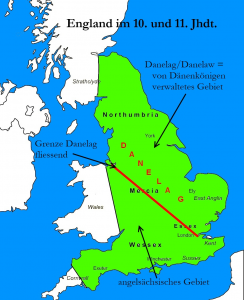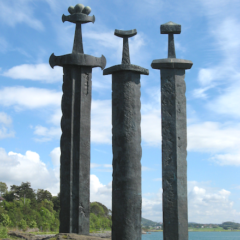The following is a rough summary of the long and complicated history of the Anglo-Saxons (24 Kings within 260 Years):
Already during the Roman occupation, Germanic tribes from Anglia, Saxonia and Jutes migrated to parts of “Britannia”, mainly to eastern and southern England. After the withdrawal of the Roman occupiers from 410 A.D. onwards, small kingdoms such as Essex, Sussex, Wessex, Kent, East Anglia, Mercia, Northumbria etc. began to form this area. From the end of the 8th century onwards, the Danish and Norwegian Vikings began to attack monasteries and small settlements along the coasts. They made their raids in spring/summer and withdrew again in autumn. Later, they even stayed over winter, for example on the Isle of Sheppey. In 865 a large Danish army landed in East Anglia – the Vikings had definitely come to stay. Firstly, they went northwards and conquered York in 866 and in November moved on to make the old Roman “Eboracum” their capital. Reinforced by fresh Danish arrivals, their interest turned south and by 870 the northern half of England was „under Danish rule”.

Danelag / Danelaw from 871/72 (Graphic: Urs Pape)
The Anglo-Saxon kings had a lot to do from 870 onwards to resist Danish pressure and did this with varying amounts of luck and skill. Here are the most prominent examples:
Alfred the Great, r. 871-899 was the most successful defender against the encroaching Vikings. He was untypical religiously and socially in not being such a warlike king and yet being very successful in resisting the Vikings. He succeeded quite well, in keeping his land, Wessex, out of the hands of the northern warriors.
Aethelread the Unread, (r. 978-1013,1014-1016) was the great loser amongst the Anglo-Saxon kings. He „fought“ the Vikings by means of prayers and celebrating masses and with payments totalling over 100,000 pounds (weight) in silver (=Danegeld). The „unread“ means „poorly advised“.
Under Knut the Great, (=Canute) (r. 1016-1035), there existed a Nordic kingdom which included England, Denmark and southern Norway and which continued throughout the reigns of the sons of Knut and Emma of Normandy, right up shortly before the Norman conquest.
